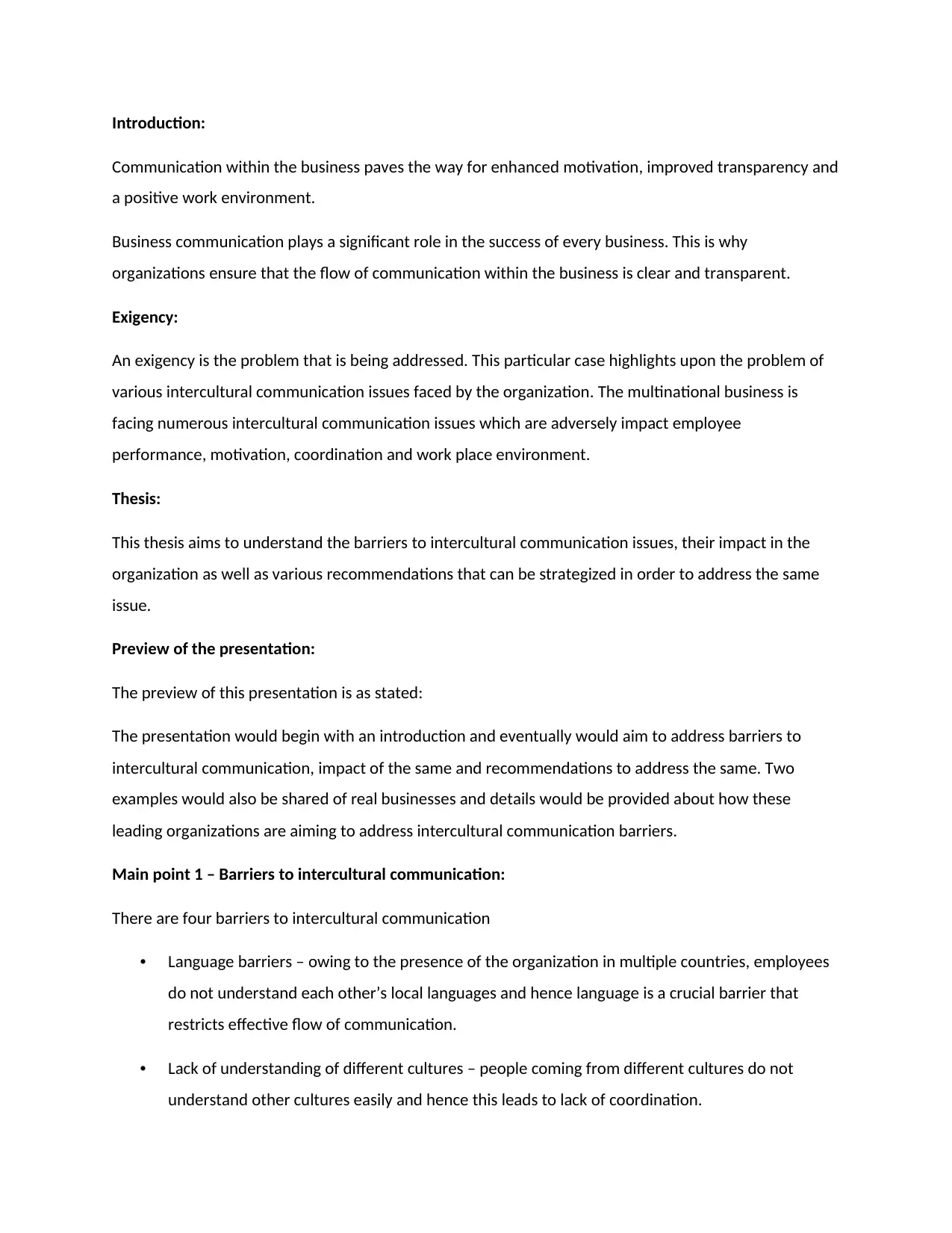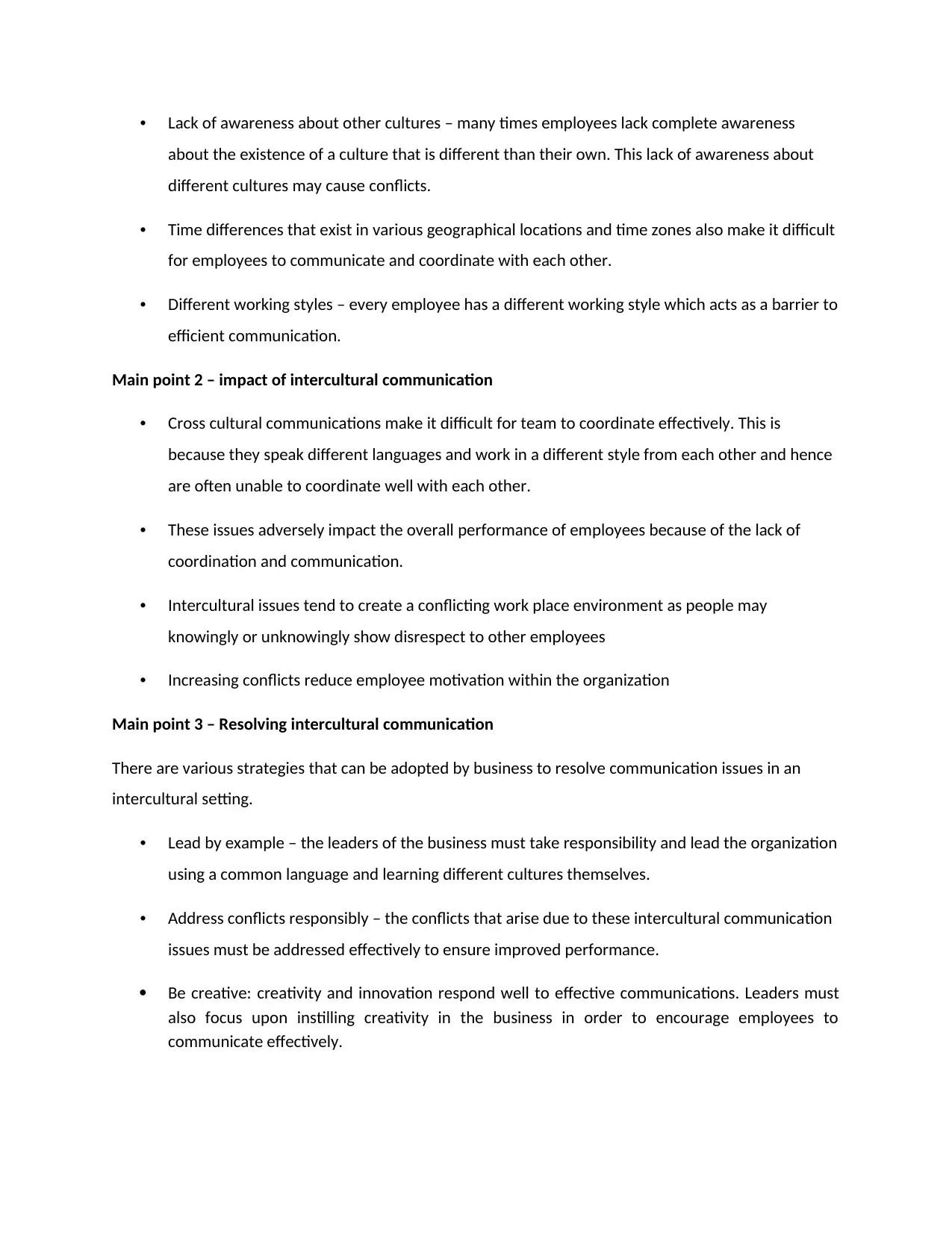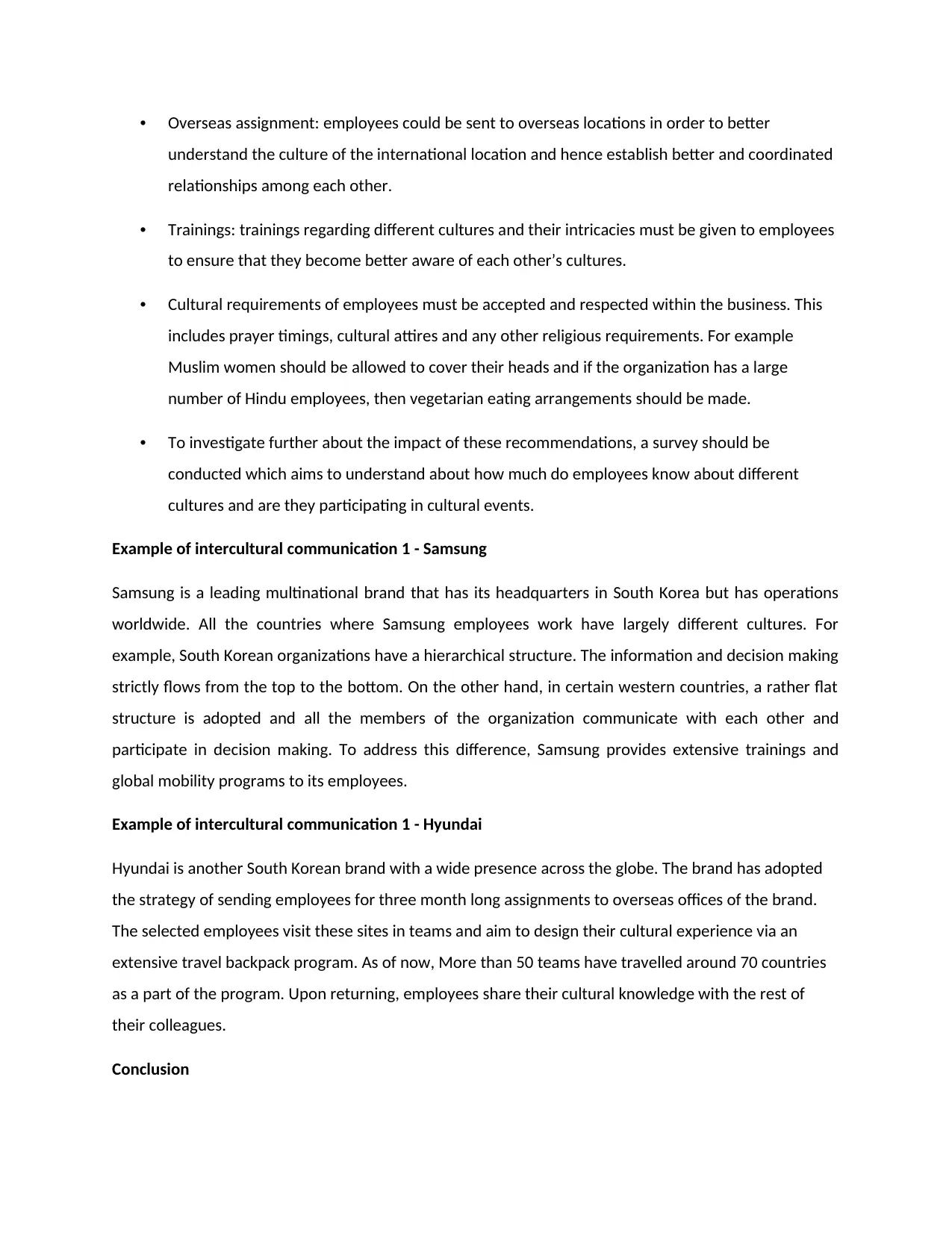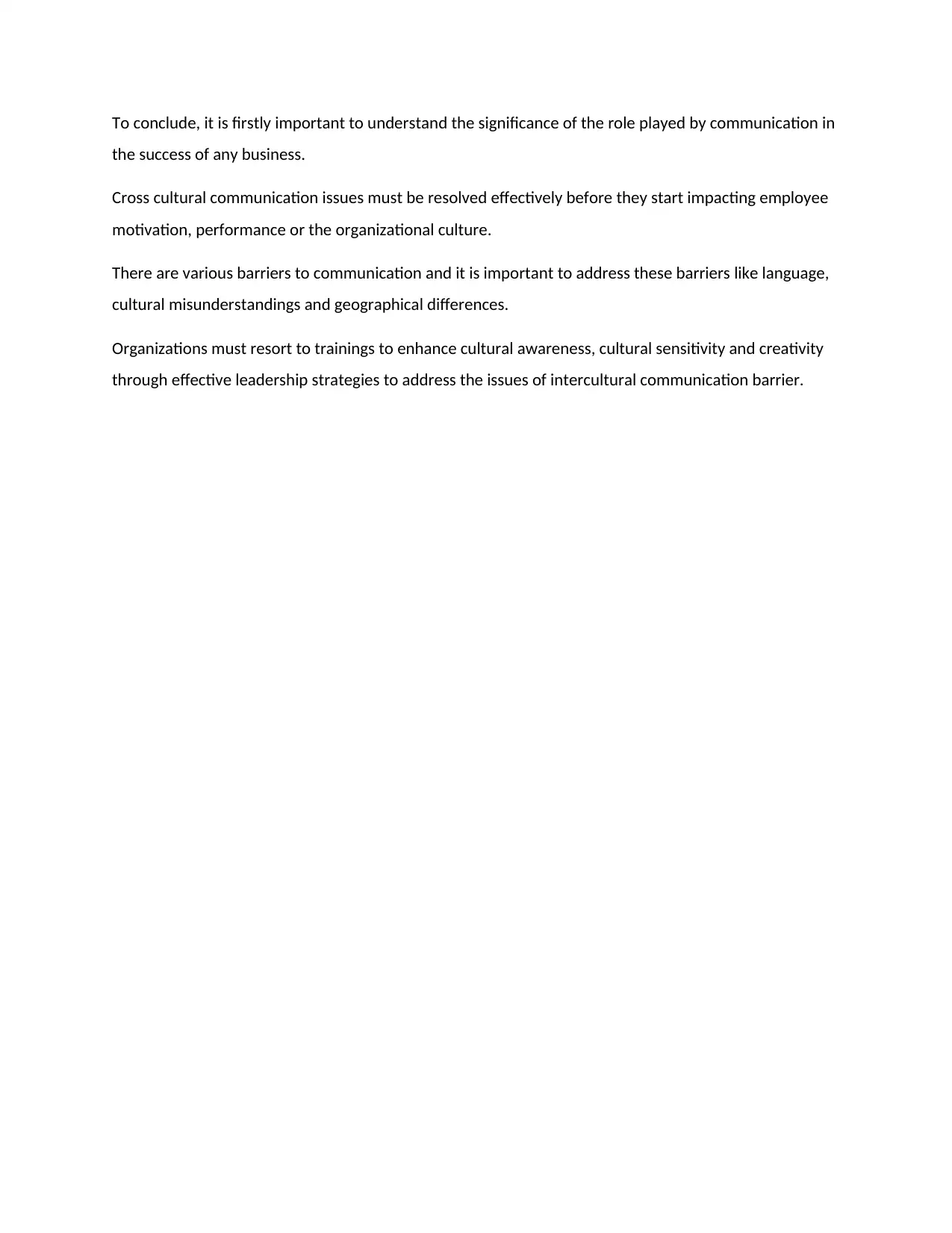Improving Intercultural Communication in Multinational Businesses
VerifiedAdded on 2021/05/31
|4
|1035
|114
Presentation
AI Summary
This presentation examines the critical role of communication in business success, particularly focusing on intercultural communication within multinational organizations. It identifies key barriers such as language differences, cultural misunderstandings, lack of awareness, and geographical time differences, highlighting their negative impact on employee performance, motivation, and workplace environment. The presentation proposes various strategies to resolve these issues, including leadership by example, conflict resolution, fostering creativity, overseas assignments, and comprehensive training programs. It emphasizes the importance of respecting cultural requirements and promoting cultural awareness. Real-world examples of how Samsung and Hyundai address intercultural communication challenges are provided to illustrate practical applications of these strategies. The presentation concludes by underscoring the need for proactive measures to mitigate communication barriers and ensure a positive and productive work environment.

Introduction:
Communication within the business paves the way for enhanced motivation, improved transparency and
a positive work environment.
Business communication plays a significant role in the success of every business. This is why
organizations ensure that the flow of communication within the business is clear and transparent.
Exigency:
An exigency is the problem that is being addressed. This particular case highlights upon the problem of
various intercultural communication issues faced by the organization. The multinational business is
facing numerous intercultural communication issues which are adversely impact employee
performance, motivation, coordination and work place environment.
Thesis:
This thesis aims to understand the barriers to intercultural communication issues, their impact in the
organization as well as various recommendations that can be strategized in order to address the same
issue.
Preview of the presentation:
The preview of this presentation is as stated:
The presentation would begin with an introduction and eventually would aim to address barriers to
intercultural communication, impact of the same and recommendations to address the same. Two
examples would also be shared of real businesses and details would be provided about how these
leading organizations are aiming to address intercultural communication barriers.
Main point 1 – Barriers to intercultural communication:
There are four barriers to intercultural communication
• Language barriers – owing to the presence of the organization in multiple countries, employees
do not understand each other’s local languages and hence language is a crucial barrier that
restricts effective flow of communication.
• Lack of understanding of different cultures – people coming from different cultures do not
understand other cultures easily and hence this leads to lack of coordination.
Communication within the business paves the way for enhanced motivation, improved transparency and
a positive work environment.
Business communication plays a significant role in the success of every business. This is why
organizations ensure that the flow of communication within the business is clear and transparent.
Exigency:
An exigency is the problem that is being addressed. This particular case highlights upon the problem of
various intercultural communication issues faced by the organization. The multinational business is
facing numerous intercultural communication issues which are adversely impact employee
performance, motivation, coordination and work place environment.
Thesis:
This thesis aims to understand the barriers to intercultural communication issues, their impact in the
organization as well as various recommendations that can be strategized in order to address the same
issue.
Preview of the presentation:
The preview of this presentation is as stated:
The presentation would begin with an introduction and eventually would aim to address barriers to
intercultural communication, impact of the same and recommendations to address the same. Two
examples would also be shared of real businesses and details would be provided about how these
leading organizations are aiming to address intercultural communication barriers.
Main point 1 – Barriers to intercultural communication:
There are four barriers to intercultural communication
• Language barriers – owing to the presence of the organization in multiple countries, employees
do not understand each other’s local languages and hence language is a crucial barrier that
restricts effective flow of communication.
• Lack of understanding of different cultures – people coming from different cultures do not
understand other cultures easily and hence this leads to lack of coordination.
Paraphrase This Document
Need a fresh take? Get an instant paraphrase of this document with our AI Paraphraser

• Lack of awareness about other cultures – many times employees lack complete awareness
about the existence of a culture that is different than their own. This lack of awareness about
different cultures may cause conflicts.
• Time differences that exist in various geographical locations and time zones also make it difficult
for employees to communicate and coordinate with each other.
• Different working styles – every employee has a different working style which acts as a barrier to
efficient communication.
Main point 2 – impact of intercultural communication
• Cross cultural communications make it difficult for team to coordinate effectively. This is
because they speak different languages and work in a different style from each other and hence
are often unable to coordinate well with each other.
• These issues adversely impact the overall performance of employees because of the lack of
coordination and communication.
• Intercultural issues tend to create a conflicting work place environment as people may
knowingly or unknowingly show disrespect to other employees
• Increasing conflicts reduce employee motivation within the organization
Main point 3 – Resolving intercultural communication
There are various strategies that can be adopted by business to resolve communication issues in an
intercultural setting.
• Lead by example – the leaders of the business must take responsibility and lead the organization
using a common language and learning different cultures themselves.
• Address conflicts responsibly – the conflicts that arise due to these intercultural communication
issues must be addressed effectively to ensure improved performance.
Be creative: creativity and innovation respond well to effective communications. Leaders must
also focus upon instilling creativity in the business in order to encourage employees to
communicate effectively.
about the existence of a culture that is different than their own. This lack of awareness about
different cultures may cause conflicts.
• Time differences that exist in various geographical locations and time zones also make it difficult
for employees to communicate and coordinate with each other.
• Different working styles – every employee has a different working style which acts as a barrier to
efficient communication.
Main point 2 – impact of intercultural communication
• Cross cultural communications make it difficult for team to coordinate effectively. This is
because they speak different languages and work in a different style from each other and hence
are often unable to coordinate well with each other.
• These issues adversely impact the overall performance of employees because of the lack of
coordination and communication.
• Intercultural issues tend to create a conflicting work place environment as people may
knowingly or unknowingly show disrespect to other employees
• Increasing conflicts reduce employee motivation within the organization
Main point 3 – Resolving intercultural communication
There are various strategies that can be adopted by business to resolve communication issues in an
intercultural setting.
• Lead by example – the leaders of the business must take responsibility and lead the organization
using a common language and learning different cultures themselves.
• Address conflicts responsibly – the conflicts that arise due to these intercultural communication
issues must be addressed effectively to ensure improved performance.
Be creative: creativity and innovation respond well to effective communications. Leaders must
also focus upon instilling creativity in the business in order to encourage employees to
communicate effectively.

• Overseas assignment: employees could be sent to overseas locations in order to better
understand the culture of the international location and hence establish better and coordinated
relationships among each other.
• Trainings: trainings regarding different cultures and their intricacies must be given to employees
to ensure that they become better aware of each other’s cultures.
• Cultural requirements of employees must be accepted and respected within the business. This
includes prayer timings, cultural attires and any other religious requirements. For example
Muslim women should be allowed to cover their heads and if the organization has a large
number of Hindu employees, then vegetarian eating arrangements should be made.
• To investigate further about the impact of these recommendations, a survey should be
conducted which aims to understand about how much do employees know about different
cultures and are they participating in cultural events.
Example of intercultural communication 1 - Samsung
Samsung is a leading multinational brand that has its headquarters in South Korea but has operations
worldwide. All the countries where Samsung employees work have largely different cultures. For
example, South Korean organizations have a hierarchical structure. The information and decision making
strictly flows from the top to the bottom. On the other hand, in certain western countries, a rather flat
structure is adopted and all the members of the organization communicate with each other and
participate in decision making. To address this difference, Samsung provides extensive trainings and
global mobility programs to its employees.
Example of intercultural communication 1 - Hyundai
Hyundai is another South Korean brand with a wide presence across the globe. The brand has adopted
the strategy of sending employees for three month long assignments to overseas offices of the brand.
The selected employees visit these sites in teams and aim to design their cultural experience via an
extensive travel backpack program. As of now, More than 50 teams have travelled around 70 countries
as a part of the program. Upon returning, employees share their cultural knowledge with the rest of
their colleagues.
Conclusion
understand the culture of the international location and hence establish better and coordinated
relationships among each other.
• Trainings: trainings regarding different cultures and their intricacies must be given to employees
to ensure that they become better aware of each other’s cultures.
• Cultural requirements of employees must be accepted and respected within the business. This
includes prayer timings, cultural attires and any other religious requirements. For example
Muslim women should be allowed to cover their heads and if the organization has a large
number of Hindu employees, then vegetarian eating arrangements should be made.
• To investigate further about the impact of these recommendations, a survey should be
conducted which aims to understand about how much do employees know about different
cultures and are they participating in cultural events.
Example of intercultural communication 1 - Samsung
Samsung is a leading multinational brand that has its headquarters in South Korea but has operations
worldwide. All the countries where Samsung employees work have largely different cultures. For
example, South Korean organizations have a hierarchical structure. The information and decision making
strictly flows from the top to the bottom. On the other hand, in certain western countries, a rather flat
structure is adopted and all the members of the organization communicate with each other and
participate in decision making. To address this difference, Samsung provides extensive trainings and
global mobility programs to its employees.
Example of intercultural communication 1 - Hyundai
Hyundai is another South Korean brand with a wide presence across the globe. The brand has adopted
the strategy of sending employees for three month long assignments to overseas offices of the brand.
The selected employees visit these sites in teams and aim to design their cultural experience via an
extensive travel backpack program. As of now, More than 50 teams have travelled around 70 countries
as a part of the program. Upon returning, employees share their cultural knowledge with the rest of
their colleagues.
Conclusion
⊘ This is a preview!⊘
Do you want full access?
Subscribe today to unlock all pages.

Trusted by 1+ million students worldwide

To conclude, it is firstly important to understand the significance of the role played by communication in
the success of any business.
Cross cultural communication issues must be resolved effectively before they start impacting employee
motivation, performance or the organizational culture.
There are various barriers to communication and it is important to address these barriers like language,
cultural misunderstandings and geographical differences.
Organizations must resort to trainings to enhance cultural awareness, cultural sensitivity and creativity
through effective leadership strategies to address the issues of intercultural communication barrier.
the success of any business.
Cross cultural communication issues must be resolved effectively before they start impacting employee
motivation, performance or the organizational culture.
There are various barriers to communication and it is important to address these barriers like language,
cultural misunderstandings and geographical differences.
Organizations must resort to trainings to enhance cultural awareness, cultural sensitivity and creativity
through effective leadership strategies to address the issues of intercultural communication barrier.
1 out of 4
Related Documents
Your All-in-One AI-Powered Toolkit for Academic Success.
+13062052269
info@desklib.com
Available 24*7 on WhatsApp / Email
![[object Object]](/_next/static/media/star-bottom.7253800d.svg)
Unlock your academic potential
Copyright © 2020–2025 A2Z Services. All Rights Reserved. Developed and managed by ZUCOL.





